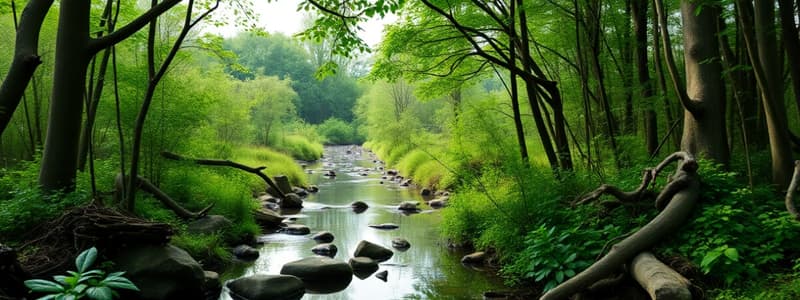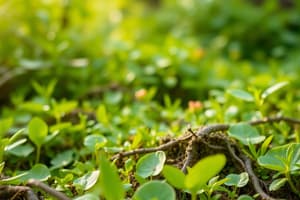Podcast
Questions and Answers
Which of these options is NOT an example of an abiotic factor?
Which of these options is NOT an example of an abiotic factor?
- Sunlight
- Water Availability
- Temperature
- Bacteria (correct)
What is the term for the relative number of individuals of a species in a defined area?
What is the term for the relative number of individuals of a species in a defined area?
- Adaptation
- Acclimation
- Albedo
- Abundance (correct)
Which term describes the adaptation of an organism to a different climate?
Which term describes the adaptation of an organism to a different climate?
- Acclimation
- Acclimatization (correct)
- Allelopathy
- Adaptation
What is the term for the chemical interaction where one plant inhibits the growth of another plant?
What is the term for the chemical interaction where one plant inhibits the growth of another plant?
What is the term for a species that is introduced to a new area, intentionally or unintentionally?
What is the term for a species that is introduced to a new area, intentionally or unintentionally?
Which term describes the variety of organisms in a specific habitat or location?
Which term describes the variety of organisms in a specific habitat or location?
Which of these is NOT a type of plant interaction?
Which of these is NOT a type of plant interaction?
Which of these is an example of an autotroph?
Which of these is an example of an autotroph?
What is the term for the weight of living organisms per unit area at a given time?
What is the term for the weight of living organisms per unit area at a given time?
What is the term for the largest ecological regions distinguishable by characteristic plants and animals?
What is the term for the largest ecological regions distinguishable by characteristic plants and animals?
What is the process by which organisms modify the environment rendering factor(s) needed for growth?
What is the process by which organisms modify the environment rendering factor(s) needed for growth?
What is the term for the upper asymptote of the sigmoid growth curve representing the upper limit imposed by the environment?
What is the term for the upper asymptote of the sigmoid growth curve representing the upper limit imposed by the environment?
What is the term for the culminating stage of plant succession in a given ecosystem?
What is the term for the culminating stage of plant succession in a given ecosystem?
What is the term for a relationship where one population is benefited but the other is not affected?
What is the term for a relationship where one population is benefited but the other is not affected?
What is the term for the portion of the earth and its atmosphere in which living organisms exist?
What is the term for the portion of the earth and its atmosphere in which living organisms exist?
What is the term for a gradient of variations in a species that stretches across a geographical location?
What is the term for a gradient of variations in a species that stretches across a geographical location?
Flashcards
Abiotic
Abiotic
Non-living factors or elements in an environment.
Abundance
Abundance
Relative number of individuals of a species in a defined area.
Acclimation
Acclimation
Reversible physical changes in an organism due to environmental pressures.
Albedo
Albedo
Signup and view all the flashcards
Allelopathy
Allelopathy
Signup and view all the flashcards
Autotroph
Autotroph
Signup and view all the flashcards
Beta diversity
Beta diversity
Signup and view all the flashcards
Amensalism
Amensalism
Signup and view all the flashcards
Biogeochemical cycles
Biogeochemical cycles
Signup and view all the flashcards
Biomass
Biomass
Signup and view all the flashcards
Carrying capacity
Carrying capacity
Signup and view all the flashcards
Climax stage
Climax stage
Signup and view all the flashcards
Commensalism
Commensalism
Signup and view all the flashcards
Biotic potential
Biotic potential
Signup and view all the flashcards
Carnivores
Carnivores
Signup and view all the flashcards
Climate
Climate
Signup and view all the flashcards
Study Notes
Abiotic and Biotic Factors
- Abiotic: Non-living components of an environment, not containing any living organisms.
- Biotic: Living organisms.
- Biotic Community: A self-sustaining community of living things; an ecosystem.
- Biotic Factor: Any environmental influence of living organisms, especially climatic and edaphic influences.
Abundance and Diversity
- Abundance: Relative number of individuals of a species in a defined area.
- Alpha Diversity (Local Diversity): Variety of organisms in a given habitat or location.
- Beta Diversity: Variety of organisms occupying a number of different habitats over a region; regional diversity.
- Biosphere (Ecosphere): Portion of Earth and its atmosphere in which living organisms exist or can support life.
- Biome: Largest ecological regions distinguishable by characteristic plants and animals.
- Biomass: Weight of living organisms per unit area at a given time.
Adaptations and Environmental Pressures
- Acclimation: Reversible physical change in an adapting organism in response to environmental pressures.
- Acclimatization: Adaptation to a different climate.
- Adaptation: Ability of species to respond to environmental constraints by developing adaptive structures through evolution to continue existence.
- Alien Species: Intentionally or unintentionally introduced organisms; some become invasive alien species (IAS).
- Allopatric Speciation: Isolation occurs through geographic separation of populations.
- Coevolution: Interactions between species impacting how both evolve.
- Cline: Gradient of variations in a species across a geographical location.
Ecosystem Components and Interactions
- Allelopathy: Chemical plant interaction where one plant inhibits another's growth.
- Amensalism: Interaction where one population is negatively affected while the other is unaffected.
- Association: Floristically homogenous vegetation types that exist as integrated units.
- Autogenic: Originating from within a system.
- Autotroph: Self-nourishing organism; capable of manufacturing its own food.
- Autecology: Approach in ecology studying organisms or a single species, a population-centered approach.
- Benthic: Organisms living on the sea floor.
- Biocoenosis: Term equivalent to the biotic component of an ecosystem.
- Biogeochemical Cycles: Movement of chemical elements between environment and organisms.
- Biological Magnification/Food Chain Concentration: Increase in levels of a certain substance as it moves through a food chain.
- Biotope: Environmentally uniform area; physical aspect of an ecosystem.
- Canopy: Overhead branches and leaves of vegetation.
- Carnivores: Consumer components of ecosystems that depend on flesh for food.
- Carrying Capacity: Amount of animal or plant life a given environment can sustainably support.
- Commensalism: Relationship where one population benefits and the other isn't affected.
- Competition: Process where organisms modify the environment to influence factors needed for growth.
- Closed System: Exchanged energy, but not matter, between its environment.
- Colluvium: Mixed deposits of soil and rock near slopes due to erosion.
- Chernozem: Common soil type in prairies, grasslands, and steppes.
- Climax: Culminating stage of plant succession in an ecosystem.
- Climate: State of atmospheric conditions on a year-to-year basis in a location.
- Climax Stage: Culminating stage of plant succession in an environment, vegetation reaching stability.
- Chablis: Formation of gaps in a forest by falling dominant or emergent trees.
- Chaparral: Evergreen shrub community adapted to dry seasons.
- Commensalism: One species benefits and the other is not affected.
Other Ecological Terms
- Albedo: Luminosity shining from a reflective surface.
- Algae Bloom: Explosion of phytoplankton, often due to pollution enriching waters.
- Alluvium: Sediment transported by water (rivers/streams).
- Amensalism: One species negatively affects another, but the latter is unaffected.
- Anemophilous: Seed plants pollinated by wind.
- Atmospheric Cycles: Nutrients like nitrogen and carbon (CO2) commonly in the atmosphere.
- Basal Area: Forest tree density expressed in square feet.
- Bog: Marshy land covered by shrubs and mosses.
- Closed system: Exchanged energy, but not matter.
- Colluvium: Soil/rock deposits accumulated at the base of slopes.
- Chernozem: Common soil type in prairies, grasslands and steppes
- Climax stage: Culminating stage of plant succession for a given environment .
- Coevolution: Interactions between species influencing both species' evolution.
- Carrying Capacity: Amount of animal or plant life an environment sustainably supports.
- Competition: Organisms in an environment impacting environmental factors necessary for growth.
- Food Chain Concentration: Increase in level of something as it moves through the food chain.
- Succession: Change in species composition (often vegetation) in an ecosystem over time.
Studying That Suits You
Use AI to generate personalized quizzes and flashcards to suit your learning preferences.




